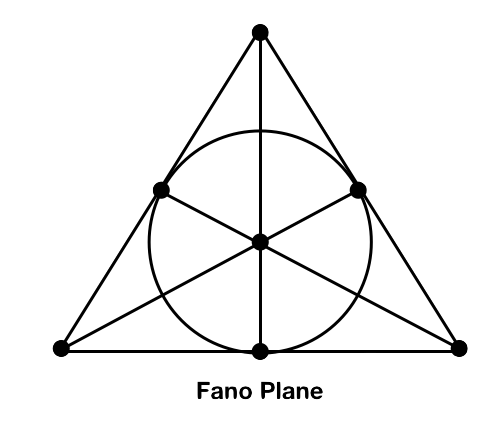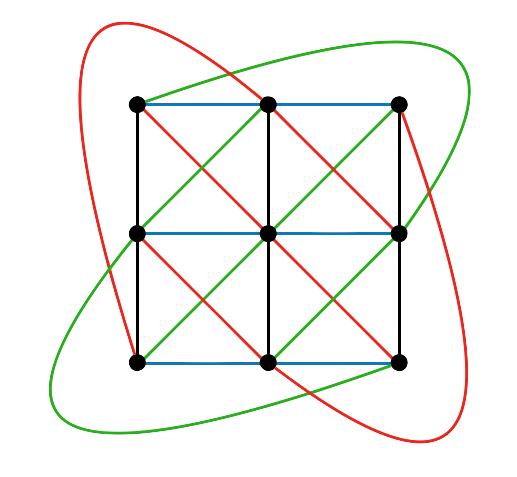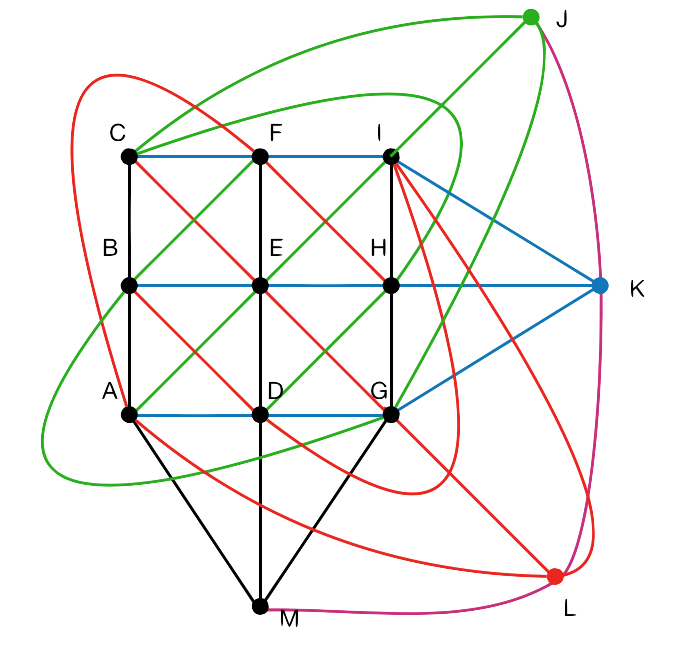Musings
Roughly speaking this is my mathematical construction space. Things that I am toying around with, some for fun and some serious, will be posted here. Most of the contents of this page will be revised again and again, so if there was something here before that has now been removed it has probably been moved to another tab.
-
SPOT-IT Card Game
SPOT-IT is a game from creators Blue Orange Games http://www.blueorangegames.com. It consists of a deck of 55 cards where each card contains 8 distinct symbols, and there are 57 different symbols in total.
The way the deck is designed is that for any two cards selected there is exactly one symbol that appears on both cards. This is quite a surprising fact! It adds an element of mystery to how such a deck was even construted in the first place.
Try designing a deck yourself, but instead of using 8 symbols per card, just limit yourself to 3 symbols per card - say A, B, C. The golden rule is that any two cards in your deck must have exactly one symbol in common. What is the largest number of cards you can have in your deck? How many distinct symbols did you need to use?
You'll likely find through trial and error that you can get at most 7 cards in your deck, and you'll need 7 distinct symbols to do it. This design can be visualized by the following diagram where each dot represents a symbol and 3 symbols connected by a line represents a card (we are considering the circle to be the 7th "line"):

If you are feeling ambitious, now try designing a deck with 4 symbols per card. Again, what is the largest number of cards you can have in your deck? How many distinct symbols did you need?
(Spoiler - The answer is 13 in each case. See bottom of this post for further description.)
Now, as it turns out the original SPOT-IT game, which consists of 55 cards, is missing two cards. That's right, the manufactures could have included an extra 2 cards in the deck, bringing it up to 57 cards (which, not coincidentally, is the number of distinct symbols in total). This deck of 57 cards would still satisfy the golden rule of Spot-It: for any two cards selected there is exactly one symbol that appears on both cards.
The missing two cards are:

How do we know there are at most 57 cards in such a deck, and how did we find the two missing cards? Great questions. This deck is an embodiment of an object in mathematics known as a finite projective plane. If we think of symbols as "points" and cards as "lines" then the golden rule of the game says any two "lines" intersect at exactly one "point". Seems to be a very nice geometric interpretation. However, there is no such thing as "parallel" lines then, since any two lines intersect. This is the nature of the word "projective" in the term finite projective plane.
I've given a few workshops on this topic to grade 8 -- 10 students, as well as middle school and high school teachers. At some point I'll put together a short article describing this game, and its remarkable connection to another card game: SET.
4-Symbol Spot-It solution:
Let's leave off with finding a solution to the 4-symbol version of Spot-It. First, there is an arrangment of 9 points and 12 lines so that each line contains exactly 3 points. Furthermore, we can see that some of the lines are parallel (i.e. do not intersect) so we colours these 12 lines using 4 colours, one colour for each parallel line class. There are
- three horizontal lines (blue),
- three vertical (black),
- three diagonal (green),
- three other diagonal (red).

Now, we want to add 4 more points to the diagram so that each line intersects at exactly one point. Since we alreay know any line of one colour intersects a line of another color then it suffices to just make parallel lines intersect. Therefore for each parallel line class we add a "point at infinity" where these parallel lines would intersect. (Think train tracks meeting in the horizon of a picture). The following diagram shows the 4 points at inifinty we've added, and we've extened each line to include it's point at infinity.

Now we have a diagram with 13 lines (12 original lines, plus the new line through the 4 points at infinity). Each line contains 4 points, and any two lines intersect at exactly one point. Therefore, if we let out cards be the "lines" and our symbols be the "points" then we have designed a 4-symbol version of Spot-It.
black lines: [C B A M], [F E D M], [I H G M]
blue lines: [C F I K], [B E H K], [A D G K]
red lines: [H F A M], [C E G L], [B D I L]
green lines: [F B G K], [A E I J], [D H C J]
line at infinity: [J K L M]
-
Spirographs
You may have had a spirograph when you were young. I was always fascinated by all the highly symmetric curves that could be drawn. It involves only a little bit of analytic geometry to work out some equations that describe the curves (this can be done after studying parametric curves in first semester calculus). Then, using a computer, you can make all the curves that the toy can produce, plus a whole lot more. Feel free to play with the following applets.
("spirograph" is a registered trademark of Hasbro, Inc)
[ Hypotrochoid ] [ Epitrochoid ]